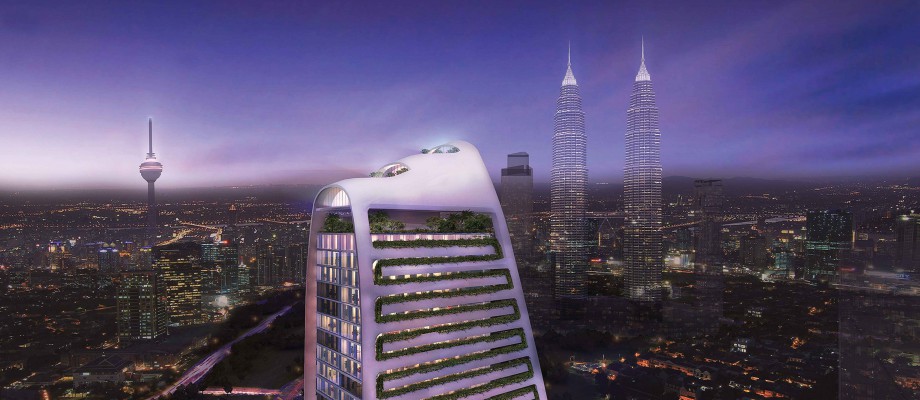
Raising standards for tall buildings
November 2nd, 2014
Taking in the sights across the island city-state of Singapore, you would be hard pushed to avoid a crick in the neck from gazing at the spectacular skyscrapers jostling for space in the business district.
At 274 square miles, and with a booming population of over 5.1m, space is at a premium; not just in the commercial heart — some 85% of the population live in highrise public housing blocks.
To mitigate the effects of such high-density development, Singapore aims to achieve a 35% improvement in energy efficiency on 2005 levels by 2030. It’s a trend playing out across south east Asia.
Among the new generation leading the charge for sustainable building design are Arham Daoudi and David Calder, alumni of The University of Nottingham’s post-graduate diploma in Architecture Tall Buildings — one of the only programmes of its kind in the world.
Both graduated in 2011 and are now based in Singapore, working at Pomeroy Studio for leading green architect Jason Pomeroy. They’ve worked on projects ranging from mixed-use high rise towers and masterplans for communities of 30,000 to what is set to become the first carbon-negative home in Singapore.
“Sustainability shouldn’t be an afterthought; it’s part of the design process,” Arham said. “We are supporting the sustainability agenda and doing it in a very practical way by integrating passive solutions from the outset.”
This moves beyond just the environmental, the design ethos of Pomeroy Studio is based on scrutinising and responding within the following established framework: environmental, technological, socio-cultural, spatial, economic.
“By analysing each project under [these parameters] we are able to ensure everything we design is holistically sustainable. Good design is driven by context, and we’re particularly inspired by the history and heritage of the site.” David explained. “The International Style, as epitomised by New York City’s seminal Lever House tower, has been replicated globally without regard for climate or context — regional differences are really important.”
Arham’s first project in the region was one of his highlights. Being part of a small team on Trump Tower Manila, which will be the tallest residential tower in the Philippines when completed in 2016, enabled him to learn a lot in a short period. “While being given guidance and support, I was awarded a tremendous amount of design independence and responsibility,” he said.
Meanwhile, David is proud of his work on The Veil, an ambitious, technically challenging mixed-use development in central Kuala Lumpur, comprising retail, food and beverage, serviced apartments, with a hotel and sky bar separated by skycourts — the first large-scale project under his supervision.
“Architecture at Nottingham gave us an advantage in concept design and thinking outside of the box. It challenged us to come up with something new and relevant,” Arham said.
This is something that was ingrained in their studies; trainee architects are given a choice of three cities in which to design a sustainable tall building. Matthew Humphreys, Pomeroy Studio’s latest intern, and winner of the 2013 Design for a Sustainable Future Award, proposed a vertical fish farm in Singapore’s Tanjong Pagar district, formerly a bustling fishing village. This nod to heritage is blended with a need to support a serious issue: Singapore clocks up a large amount of food miles, with 95% of it coming from imports.
But while the environmental credentials may be covered, can these awe-inspiring creations match up when it comes to financial sustainability?
Dr Philip Oldfield, Course Director of the Masters in Sustainable Tall Buildings at Nottingham, said: “In general terms, green buildings may be 1-5% more expensive in the short term, but they would be cheaper in the long term for two reasons; the first is the obvious reduction in energy bills. But the second is even more important — whist the building is expensive, the wages of those who work there are even more expensive.
“If, through providing shade, natural ventilation, natural light and social spaces we can improve the productivity or reduce the illness of people who work in these buildings by only a small percentage, it can make a huge difference financially, and make these ideas more economically viable.
“I am however conscious of the ground breaking work Pomeroy Studio are doing in creating cutting edge sustainable design to tight budgets in emerging Asian markets, and have even come out with a carbon negative house that is cheaper than an average bungalow in that area of Singapore.
“I’m delighted that David, Arham and Matthew are able to contribute to the green agenda, and have been able to find a studio that bucks the ‘business as usual’ trend and are creating meaningful, economically viable sustainable architecture.”
Visit: www.pomeroystudio.sg
Tags: Arham Daoudi, David Calder, Dr Philip Oldfield, Jason Pomeroy, Masters in Sustainable Tall Buildings, Pomeroy Studio, post-graduate diploma in Architecture Tall Buildings
Comments are closed.
Other News

Need news? See you on SharePoint
After 14 years of service, Campus News is being retired as the university’s staff news platform. […]

Roads and car parks closed for refurbishing work
As part of ongoing road improvements at the university, works will be taking place to resurface […]

